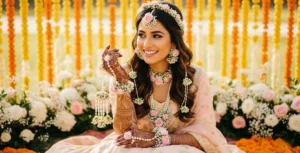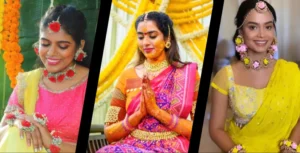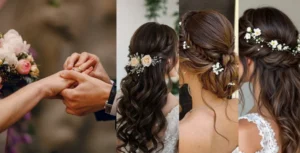South Indian weddings are a vibrant celebration of culture, rituals, and tradition, marked by grandeur and spiritual significance. From the sacred muhurtham to colorful pre-wedding rituals, every ceremony has its unique dress code.
Whether you’re a bride, groom, family member, or guest, dressing appropriately not only reflects respect for customs but also enhances your presence. From traditional ceremonies to grand receptions, knowing what to wear in a South Indian wedding can make all the difference. This comprehensive guide will help you navigate outfit choices for every wedding event with grace and style.
Wedding Attire for the Bride and Groom
Bride’s Traditional Look

The attire that South Indian brides wear represents the rich heritage as well as the luxurious nature of their traditions. The finest traditional saree selection is Kanjeevaram, which people commonly refer to as Pattu sarees. Kept in high regard for their deep colors and brilliant zari borders and temple-related motifs present in these silk sarees. Brides normally select red and gold alongside green and royal blue colors to symbolize good luck on their wedding day.
Blouse pieces require equal importance as they are decorated elaborately with beads, sequins, or thread-work. Temple jewelry crafted from gold brings lavishness to wedding appearances by incorporating multiple harams, maang tikka, nose rings, along with bangles and vanki armbands and oddiyanam waist belts. Women show their hair with neat braids authentic with jasmine flowers and poolajada (decorative floral braid) that symbolize both visual beauty and cultural notions of purity along with prosperity.
Groom’s Traditional Look
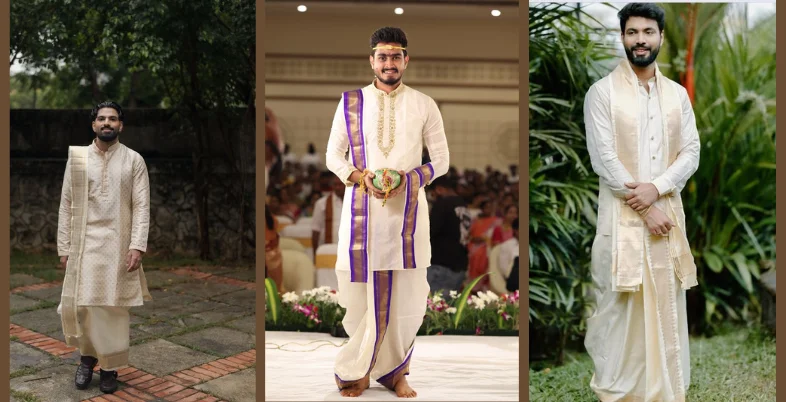
The traditional clothing of South Indian grooms might look basic initially, yet it represents a comprehensive legacy. A man wears a veshti made from pure silk while draping the angavastram across his body as an additional accessory. Selections of white and cream shirts or kurta provide a suitable finishing touch for the ensemble. Telugu and Tamil Brahmin weddings require groomsmen to embrace the practice of wearing silk uttariyam and peta or kondai turbans, specifically during the muhurtham.
Main wedding accessories for grooms include gold chains together with wristwatches and forehead tilak but more and more men now choose to wear rings or bracelets. The ensemble achieves a perfect blend of masculine tradition alongside sacred simplicity, which results in an elegant yet culturally acceptable appearance.
Outfits for Family Members and Close Relatives
Bridesmaids and Sisters
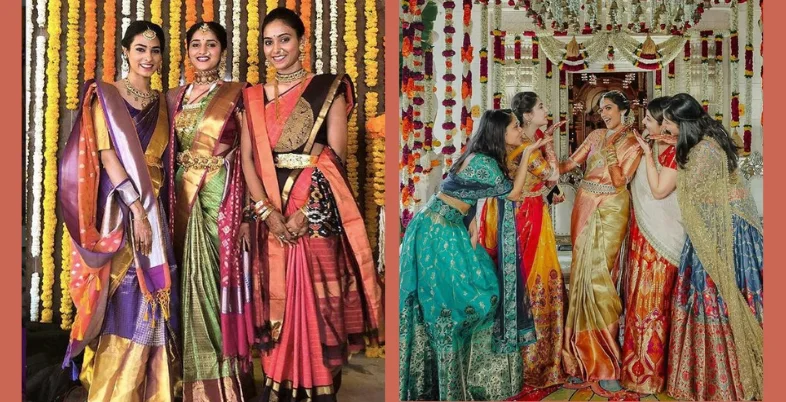
Bridesmaids and close female relatives typically dress in traditional attire that complements the bride’s overall style. The best options are silk sarees, half-sarees (langa voni), or designer lehengas in jewel tones, including mustard, teal, emerald, and magenta. Silk, organza, or brocade are examples of fabrics that look festive yet are lightweight enough for lengthy festivities.
Hair is frequently adorned with fresh flowers or tiny poolajadas and fashioned in buns or braids. To keep the bridal motif consistent, accessories like counterfeit gold sets or antique temple jewelry are frequently used. The ethnic look is finished with matching bindi, nose pins, and bangles.
Brothers and Male Relatives
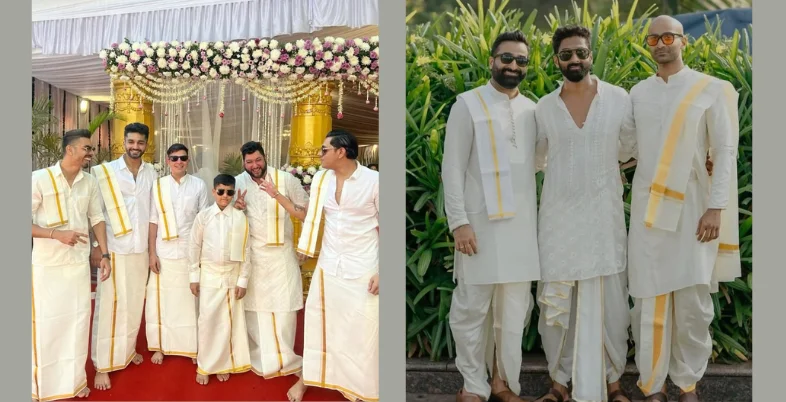
Brothers and other close male family members wear traditional veshtis with silk shirts or kurtas during the wedding ceremony. For the reception or engagement, they can shift to stylish sherwanis or Nehru jackets paired with churidar pants. Popular colors include cream, gold, navy blue, and maroon. Adding a matching angavastram or stole can enhance the ensemble. Footwear like mojaris or traditional sandals ties the look together without compromising comfort.
Guest Attire for Different Functions
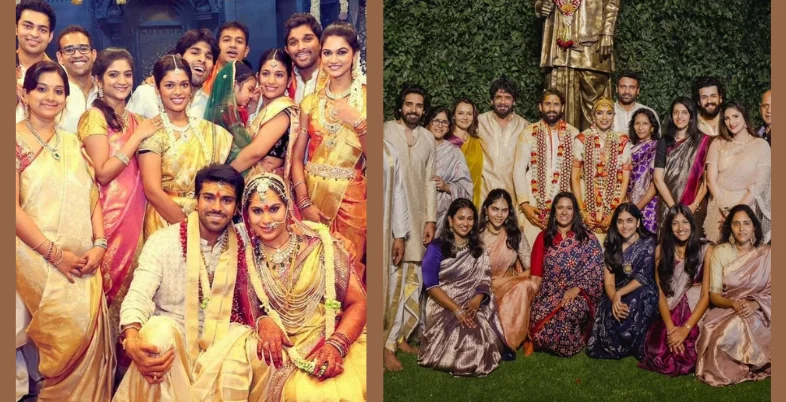
Female Guests
At South Indian wedding ceremonies, guests follow customary fashion etiquette by selecting modest clothing choices. The main wedding ceremony calls for silk sarees as one of the most preferred choices for guests. Guests attending pre-wedding events can select cotton sarees or chiffon sarees or salwar suits for their formal attire. Younger guests can choose Lehenga-cholis in non-bright colors as acceptable wedding attire.
Wearing either red or green or pink with gold or any variation of these hues represents typical South Indian celebration colors at weddings. During celebratory events, it is best to stay away from dark colors and whites because these tones are traditionally linked to mourning rituals and spiritual purity. Simple jewelry along with a neat hairstyle and a bindi, create a culturally respectful appearance when paired with the outfit.
Male Guests
A beige or a white dhoti paired with a shirt serves as suitable clothing for male guests at the muhurtham celebrations. The reception demands formal or semi-formal clothing which includes silk kurta combined with churidar or a sherwani as the proper attire. Watches and simple chains complete the outfit without dominating its appearance. Men finish their attire with closed-toe sandals or mojaris which create a fashionable yet relaxed appearance.
Dress Code for Pre-Wedding Ceremonies
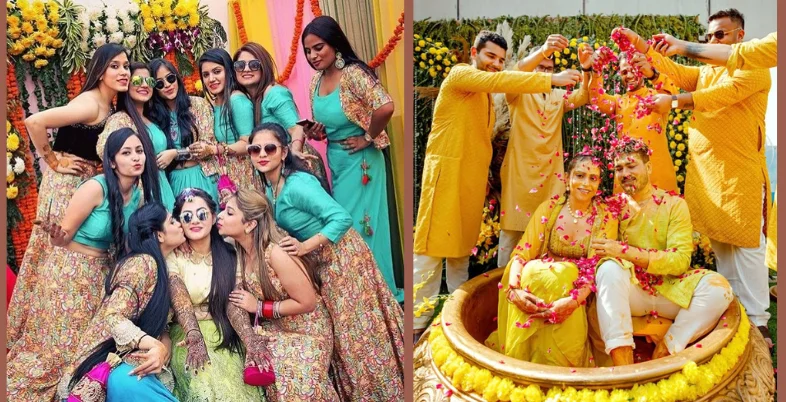
Haldi Ceremony
The haldi ceremony is typically intimate, filled with laughter and turmeric. Since turmeric can stain fabrics permanently, it’s best to wear yellow or mustard clothes made of cotton or georgette. Women can wear simple sarees or kurtis, while men can choose casual cotton kurtas or linen shirts. Avoid heavy embroidery or expensive fabrics. Add floral accessories like a gajra or floral bangles for a cheerful, traditional touch.
Mehendi & Sangeet
These events are lively and colorful, so it’s a great time to experiment with contemporary ethnic styles. Women often wear lehengas, floor-length anarkalis, or Indo-Western fusions in colors like fuchsia, lime green, or coral. Traditional accessories like poola jada jewelry can beautifully complement these looks. Men can go for kurta-pyjama sets with embroidered Nehru jackets or printed bandhgalas. Comfortable footwear is a must, especially if there’s dancing involved. Funky accessories and playful jewelry are welcome here!
Accessories and Footwear
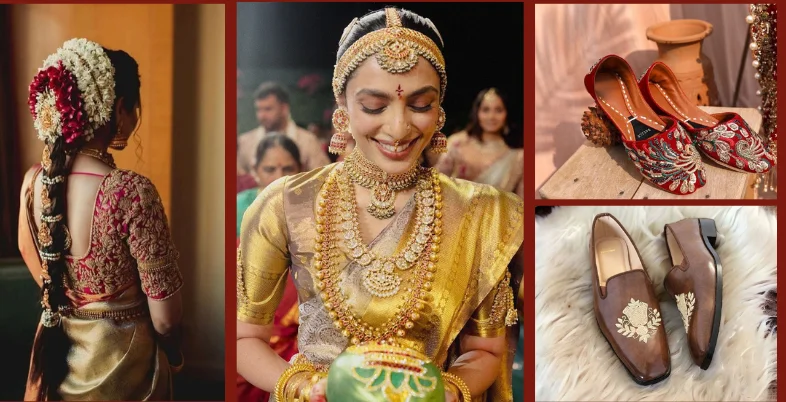
Jewelry and Hair Accessories
South Indian wedding attires are incomplete without jewelry because these items serve as essential dressing elements. The status of gold prevails above all other resources in South Indian wedding customs, particularly when it involves brides and their immediate family members. Temple jewelry featuring motifs of Goddess Lakshmi combined with elephants and mango leaves brings traditional Indian elements to the design.
The outfit of traditional female adornments includes jhumkas with kamarbandh alongside maang tikka and bangles. Women enhance their hair by combining flowers with delicate clips and passionate poolajadas to reach divine elegance. A man’s traditional wedding jewelry consists mainly of simple items, including a gold necklace along with bracelets and an ethnic ring. Sandalwood applied as a tilak on the forehead serves as both a symbolic ornament and a spiritual element for enhancing ceremonial ambiance.
Footwear Tips
Shoes should combine functionality and history. Many wedding ceremonies are performed indoors, when shoes are taken off, or in temples. Therefore, choose flats or sandals that are easy to put on. Women might choose kolhapuris or low-heeled, adorned juttis. Men can dress in open sandals, chappals, or mojaris. Steer clear of closed shoes or stilettos that are difficult to remove when entering and leaving the theater frequently.
Conclusion
In conclusion, South Indian weddings are a symphony of rituals, colors, and cultural pride. It’s not just about looking good; it’s also about respecting tradition, experiencing the joy of being with others, and honoring tradition. Every aspect of the clothing, from the sophisticated poolajada to the splendor of silk sarees and veshtis, captures the essence of South Indian culture. Whether you are a guest or a participant in the wedding, let your attire convey elegance and joy.
FAQs
What type of makeup and hairstyle goes best with South Indian wedding attire?
Traditional South Indian bridal or guest looks usually pair well with dewy or gold-toned makeup and defined eyes. For hairstyles, long braids decorated with jasmine flowers, poolajadas, or traditional clips are most popular for saree looks. For guests or those wearing lehengas, a bun adorned with flowers or a half-up-half-down style also works well. Minimal makeup is best for daytime ceremonies, while you can go bolder for evening events like the reception.
How should I dress if I’m attending a temple wedding?
If the wedding is taking place in a temple, modesty and tradition are key. Women should wear full-length sarees or long salwar suits, with shoulders and midriffs covered. Men should ideally wear a dhoti with a shirt or kurta, and in many temples, wearing Western trousers inside the sanctum may not be allowed. Carry a dupatta or shawl as a sign of respect, and wear easy-to-remove footwear since you’ll likely be barefoot inside the temple.
Is artificial or imitation jewelry acceptable at South Indian weddings?
Absolutely. While real gold and temple jewelry are traditionally worn by the bride and close relatives, high-quality imitation jewelry is widely accepted and very common, especially among guests and extended family. Many stores even offer bridal-style sets in imitation gold that look equally grand but are budget-friendly. Just make sure the designs match the traditional aesthetic—opt for antique gold tones over shiny modern metals.


